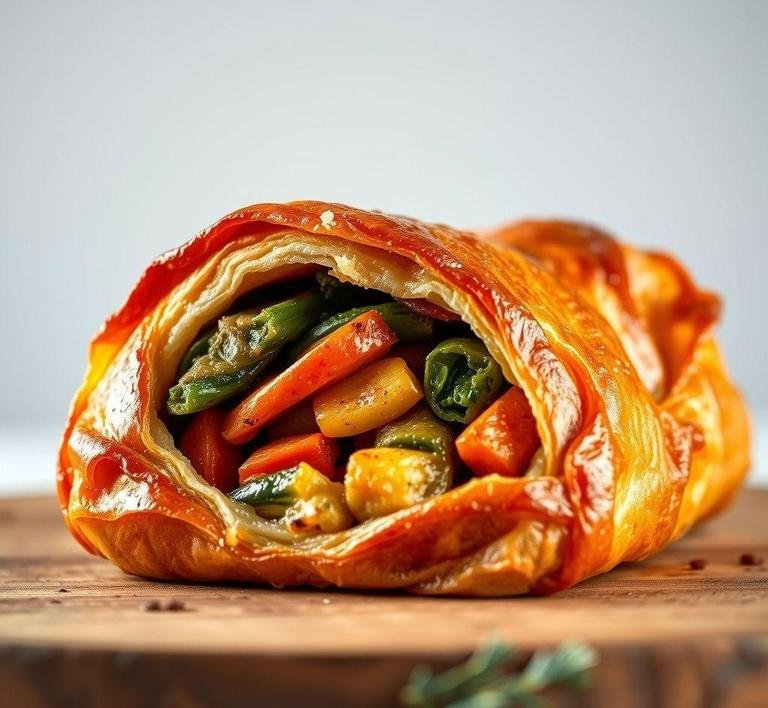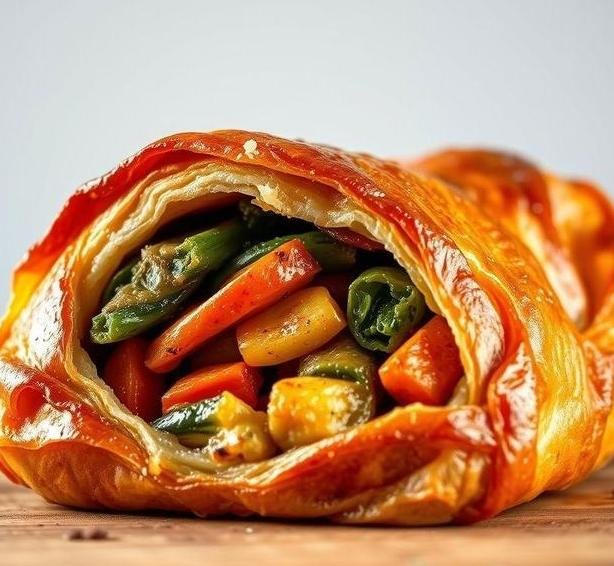Mary Berry’s Roasted Vegetable Wellington is a vegetarian twist on the classic beef Wellington, renowned for its decadent layers of flavors wrapped in a golden, flaky pastry shell. The dish celebrates a variety of roasted vegetables, seasoned and arranged with finesse, encased in a buttery puff pastry that crisps to perfection as it bakes. The combination of tender, roasted vegetables like mushrooms, carrots, squash, and onions creates a hearty, satisfying filling that mimics the rich, savory essence of the traditional Wellington, but without any meat.
Mary Berry, a British culinary legend, is known for her simple yet elegant approach to cooking, and her Roasted Vegetable Wellington is no exception. The recipe strikes a balance between comfort and sophistication, perfect for a festive occasion or as a show-stopping main course at a dinner party. The dish is celebrated not only for its vibrant presentation but also for its versatility; the ingredients can be customized to suit any season, offering flexibility to home cooks.
What makes this version stand out is the careful layering of ingredients that ensures a deep, umami-packed filling, while the crispness of the pastry provides a satisfying texture. It’s a perfect dish for anyone looking to explore vegetarian cooking without sacrificing the indulgence and richness typically associated with classic holiday or celebratory dishes.
Mary Berry’s Roasted Vegetable Wellington Recipe
Ingredients Needed

To prepare Mary Berry’s Roasted Vegetable Wellington, you’ll need a variety of fresh, seasonal vegetables and a few pantry staples. Here’s a breakdown of the key ingredients:
- Puff Pastry: The star of the Wellington, puff pastry creates the iconic, golden crust. You’ll need about 2 sheets of ready-rolled puff pastry to ensure your Wellington has a generous outer layer.
-
Roasted Vegetables
- Mushrooms (preferably chestnut or button mushrooms): These provide the meaty texture that’s essential in a Wellington, adding both depth and moisture.
- Carrots: Their sweetness balances the savory flavors of the other vegetables and adds color to the filling.
- Butternut Squash: This vegetable brings a subtle sweetness and smooth texture, offering richness and a slight caramelization when roasted.
- Onions: Yellow or red onions will bring a savory, slightly sweet flavor when roasted, helping to create a well-rounded filling.
- Garlic: For seasoning, garlic infuses the vegetables with depth and aroma.
- Spinach: Adds freshness, color, and a slight earthiness to the filling, helping to balance the richness of the roasted vegetables.
- Seasoning: A blend of salt, pepper, and dried herbs such as thyme or rosemary will enhance the natural flavors of the vegetables. A pinch of nutmeg could be added for extra warmth and complexity.
- Dijon Mustard: Used to brush on the pastry before assembling, Dijon mustard adds a touch of sharpness that cuts through the richness of the vegetables and pastry.
- Egg Wash: An egg wash (whisked egg with a splash of water) is essential for giving the pastry its golden, glossy finish as it bakes.
- Olive Oil: For roasting the vegetables, a drizzle of olive oil will help achieve that lovely caramelization and crispness.
Equipment Needed
While the recipe doesn’t require any specialized tools, there are a few essential pieces of equipment that will make the process smoother and more efficient:
- Roasting Tray: To roast the vegetables, a large roasting tray with enough space for even heat distribution is crucial.
- Baking Tray: This will be used to bake the assembled Wellington in the oven. Make sure to line it with parchment paper to prevent the pastry from sticking.
- Sharp Knife: You’ll need a good, sharp knife for chopping the vegetables into uniform pieces.
- Pastry Brush: To apply the egg wash and Dijon mustard to the pastry, a pastry brush ensures an even coat for the perfect golden finish.
- Rolling Pin: If you’re using pastry sheets that need a little extra rolling, a rolling pin can help ensure the pastry is the right thickness.
- Cling Film: For rolling the Wellington, cling film is useful to help shape and hold the pastry while it chills before baking.
Instructions To Make Mary Berry’s Roasted Vegetable Wellington
- Preheat the Oven: Start by preheating your oven to 200°C (180°C fan)/400°F/Gas mark 6. This ensures your oven is at the perfect temperature to roast and bake the Wellington.
-
Roast The Vegetables
- Peel and chop your carrots and squash into small chunks. Slice your mushrooms and onions. Mince the garlic.
- Toss the vegetables in a little olive oil, salt, pepper, and your choice of herbs (rosemary or thyme work wonderfully). Roast the vegetables on a baking tray for about 20-25 minutes, until they’re tender and lightly caramelized. Keep an eye on them to ensure they don’t overcook.
- Sauté the Spinach: While the vegetables are roasting, heat a pan over medium heat and sauté the spinach until it wilts down. Once cooked, place it in a sieve and press out any excess moisture to avoid soggy pastry.
- Prepare the Mustard and Egg Wash: In a small bowl, whisk the egg with a splash of water to make the egg wash. Brush a thin layer of Dijon mustard over the pastry sheets to add flavor and keep the filling in place.
-
Assemble The Wellington
- Once the roasted vegetables have cooled slightly, mix them with the sautéed spinach. Check the seasoning, adding more salt, pepper, or herbs if needed.
- Lay out the two sheets of puff pastry on a lightly floured surface, overlapping them slightly if needed. Spread a thin layer of the vegetable mixture in the center, leaving space around the edges.
- Carefully fold the pastry over the filling to encase it. Trim any excess pastry and pinch the edges to seal. You can use a fork to crimp the edges for a decorative touch.
- Chill the Wellington: Before baking, wrap the assembled Wellington in cling film and refrigerate for 30 minutes. This helps the pastry set and ensures it holds its shape during baking.
- Bake the Wellington: Preheat your oven to 200°C (180°C fan)/400°F/Gas mark 6. Brush the outside of the Wellington with the egg wash, then bake for 25-30 minutes, or until the pastry is golden brown and puffed up.
- Serve: Let the Wellington rest for a few minutes before slicing. This allows the filling to firm up, making it easier to cut clean slices.
Tips And Tricks
- Vegetable Variations: Feel free to swap or add other vegetables depending on what’s in season. Root vegetables like parsnips or sweet potatoes work well, or you can add leeks for a milder onion flavor.
- Pre-roast the Vegetables: Don’t skip the step of roasting the vegetables beforehand. It helps concentrate their flavors and removes excess moisture, which could make the pastry soggy.
- Egg Wash Alternatives: If you’re looking for a vegan version, you can use plant-based milk or aquafaba (the liquid from canned chickpeas) as an egg wash to get a similar golden finish.
- Puff Pastry Secrets: Ensure the pastry is kept cold before baking to achieve the flakiest texture. If it starts to soften while you’re working with it, pop it back in the fridge for a few minutes.
- Make Ahead: You can assemble the Wellington a day before, refrigerate it, and bake it on the day. This will save time and still yield excellent results.
Mary Berry’s Roasted Vegetable Wellington is a dish that effortlessly combines comfort with elegance, making it a perfect choice for vegetarians and anyone looking to explore plant-based cooking. The balance of roasted vegetables wrapped in flaky puff pastry makes every bite a delightful experience, while the flexibility of the recipe means you can tailor it to your tastes and the seasons.
Whether you’re making it for a special occasion or a weekend dinner, this Wellington will impress with its striking presentation and rich, savory flavors. With a few tips and a bit of patience, you’ll have a masterpiece that rivals any meat-based dish. It’s a celebration of vegetables in their best form-wrapped in pastry and baked to perfection.
Easy Recipe Variations For Mary Berry’s Roasted Vegetable Wellington

Mary Berry’s Roasted Vegetable Wellington is already a show-stopping dish, perfect for vegetarians, vegans, or anyone looking to enjoy a hearty, flavor-packed meal. But as with many classic recipes, there’s always room for creative variations to suit personal preferences, dietary restrictions, or to simply spice things up. Below are a few fun and easy variations that can make the Wellington even more versatile:
1. Cheese Lovers’ Twist
While traditional vegetable Wellingtons are often made with a medley of root vegetables, mushrooms, and greens, adding cheese can elevate the flavor profile. Try incorporating a layer of sharp cheddar or creamy goat cheese into the filling for an extra dose of richness. If you’re after something more luxurious, a blue cheese like Roquefort or Stilton would complement the earthiness of the vegetables beautifully.
To do this: Once the roasted vegetables are cooled and ready to be wrapped in puff pastry, spread a thin layer of cheese over the vegetable mixture before adding the pastry. For a more indulgent touch, you can also sprinkle grated cheese on top of the pastry before baking, creating a golden, cheesy crust.
2. Spicy Kick
For those who enjoy a little heat, you can add spices like chili flakes, smoked paprika, or even harissa to the roasted vegetable filling. The subtle smokiness of the paprika pairs well with sweet vegetables like carrots and parsnips, while chili flakes can introduce a fiery undertone. If you’re using harissa, blend a small spoonful into the roasted vegetables for a Mediterranean flavor boost.
To do this: Mix the spices directly into the vegetable filling after roasting. You can even marinate the vegetables with olive oil and the spices before roasting to allow the flavors to meld and intensify.
3. Mushroom Medley
Mushrooms are already a key player in Mary Berry’s original recipe, but you can enhance this element by opting for a variety of mushrooms, such as portobello, shiitake, and oyster mushrooms. These mushrooms provide different textures and an added depth of flavor that’ll take the Wellington to new heights.
To do this: Slice the mushrooms and sauté them with garlic, thyme, and a splash of white wine before layering them into the pastry. This creates a rich, savory filling that complements the vegetables and adds a satisfying umami punch.
4. Nutty And Fruity
If you’re craving a bit of texture and sweetness, consider adding nuts and dried fruits to the filling. Walnuts, pecans, or even hazelnuts can add crunch, while dried apricots, cranberries, or raisins offer a burst of sweetness. These ingredients provide a lovely contrast to the savory elements and introduce an unexpected twist.
To do this: Chop the nuts coarsely and scatter them over the vegetable mixture. You can also mix the dried fruits in with the vegetables before rolling them in the pastry.
5. Vegan Version
For a vegan-friendly take on the Wellington, simply replace the butter in the pastry with a plant-based alternative and ensure your filling is completely free from animal products. Swap out any cheese for vegan cheeses made from nuts, tofu, or coconut. Vegan puff pastry is also widely available in stores now, or you can make your own at home.
To do this: Use a dairy-free margarine or coconut oil for the pastry, and for the filling, choose vegetables like squash, sweet potatoes, and leeks, all of which have a natural sweetness and texture perfect for a vegan Wellington.
Storing Leftovers
Mary Berry’s Roasted Vegetable Wellington, while delicious and rich, often makes a large portion, which can easily provide for multiple meals. Properly storing leftovers ensures that you can enjoy this fantastic dish on another day, without compromising its flavor or texture.
1. Refrigeration
The best way to store leftover Wellington is by wrapping it tightly in plastic wrap or placing it in an airtight container to keep the puff pastry crisp. Ideally, it should be consumed within 2-3 days for the best taste and texture. The vegetables will remain fresh in the fridge, but the puff pastry may soften slightly over time due to moisture from the filling.
To do this: Slice the Wellington into individual portions before storing, as this makes it easier to reheat and prevents excessive exposure to air.
2. Freezing
If you’ve made a large batch and want to extend the shelf life, freezing is a great option. Ensure that the Wellington is completely cooled before wrapping it tightly in plastic wrap and then in aluminum foil. Freezing the Wellington whole or in slices works well, but be mindful that the puff pastry might lose a bit of its flakiness after freezing and reheating.
To do this: Wrap the Wellington tightly in plastic wrap and then in foil to prevent freezer burn. Label the package with the date so you can keep track of how long it’s been in the freezer. For the best results, consume frozen Wellington within 1-2 months.
3. Reheating
When it’s time to enjoy your leftovers, reheating is simple, but it’s important to restore some of the pastry’s original crispness. The oven is the best method for reheating, as microwaving may make the pastry soggy. Preheat your oven to 350°F (175°C) and place the leftover Wellington on a baking sheet. Bake for 10-15 minutes, or until the pastry is golden and crisp again.
To do this: If the Wellington was frozen, let it thaw in the fridge overnight before reheating. This helps prevent the pastry from becoming too soggy during the reheating process.
What To Eat With Mary Berry’s Roasted Vegetable Wellington?
Mary Berry’s Roasted Vegetable Wellington is a hearty and flavorful dish on its own, but pairing it with the right sides can turn a simple meal into an extraordinary feast. Here are some complementary dishes that will enhance your Wellington experience:
1. A Fresh Green Salad
A vibrant salad with mixed greens and a tangy vinaigrette works wonders to balance the richness of the Wellington. The crispness and freshness of the salad provide a refreshing contrast to the deep, savory flavors of the pastry and roasted vegetables. You can also add nuts, seeds, and berries for texture and extra flavor.
To do this: Try a simple arugula salad with lemon dressing, or go for a more elaborate combination with roasted beets, goat cheese, and candied walnuts.
2. Garlic Mashed Potatoes
For a comforting side dish, garlic mashed potatoes are always a winner. The creamy potatoes pair beautifully with the flaky pastry and roasted vegetables, adding a touch of indulgence. You could even make them with roasted garlic for a sweeter, milder flavor.
To do this: Boil peeled potatoes until tender, then mash with butter (or a plant-based alternative), cream, and roasted garlic. Season with salt and pepper for a creamy, flavorful side.
3. Roasted Vegetables
If you want to keep the vegetable theme strong, roasted root vegetables like carrots, parsnips, and sweet potatoes are a great choice. Their natural sweetness and caramelization will enhance the flavors in the Wellington. You can even toss the vegetables in herbs like rosemary and thyme for added fragrance.
To do this: Chop your vegetables into uniform sizes, toss with olive oil, salt, and pepper, and roast at 400°F (200°C) for 25-30 minutes, until golden and tender.
4. Gravy Or Vegan Gravy
A rich, savory gravy can elevate the Wellington even further. If you’re looking for a vegan alternative, mushroom gravy is a perfect match, as its umami flavor pairs wonderfully with the roasted vegetables. You can prepare it ahead of time and reheat when serving.
To do this: For vegan gravy, sauté onions and mushrooms, add vegetable broth, and let it simmer. Thicken with cornstarch or flour, and season to taste.
Conclusion
Mary Berry’s Roasted Vegetable Wellington is an exceptional dish that combines vibrant roasted vegetables, flaky pastry, and deep, savory flavors. Its versatility allows for endless variations, whether you prefer a cheesy, spicy, or nutty twist. By storing leftovers properly and pairing the Wellington with complementary sides, you can enjoy it again and again. From casual weeknight dinners to special occasions, this dish is sure to impress, providing both delicious nourishment and a satisfying, comforting experience. Whether you’re an experienced cook or a beginner, it’s a dish that showcases the beauty of simple ingredients transformed into something extraordinary.
FAQs
What Vegetables Are Used In Mary Berry’s Roasted Vegetable Wellington?
In Mary Berry’s roasted vegetable Wellington, the recipe typically includes a mix of hearty vegetables such as butternut squash, carrots, and mushrooms. These vegetables are roasted to bring out their natural sweetness and flavor before being wrapped in puff pastry. You can also add other vegetables like parsnips or sweet potatoes, depending on your preferences.
Can I Make Mary Berry’s Roasted Vegetable Wellington Ahead Of Time?
Yes, you can make Mary Berry’s roasted vegetable Wellington ahead of time. After assembling the Wellington, you can refrigerate it for up to 24 hours before baking. To bake, allow it to come to room temperature before placing it in the oven. Alternatively, you can freeze the assembled Wellington and bake it directly from frozen, though it may require a slightly longer baking time.
How Can I Ensure The Puff Pastry On Mary Berry’s Roasted Vegetable Wellington Is Crispy?
To ensure the puff pastry on Mary Berry’s roasted vegetable Wellington turns out crispy, there are a few important steps to follow. First, make sure the pastry is cold before baking, as this will help it puff up. Second, brush the pastry with a light coating of egg wash to give it a golden, glossy finish. Finally, place the Wellington on a baking tray lined with parchment paper and bake it in a preheated oven at a high temperature, typically around 200°C (400°F), for 25-30 minutes until the pastry is golden and crisp.


